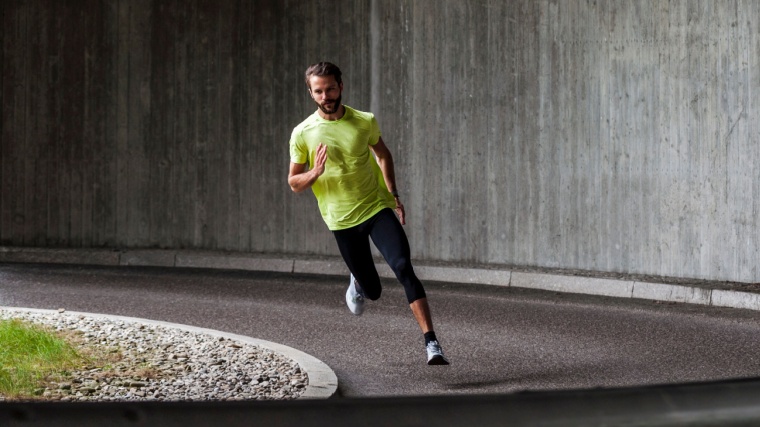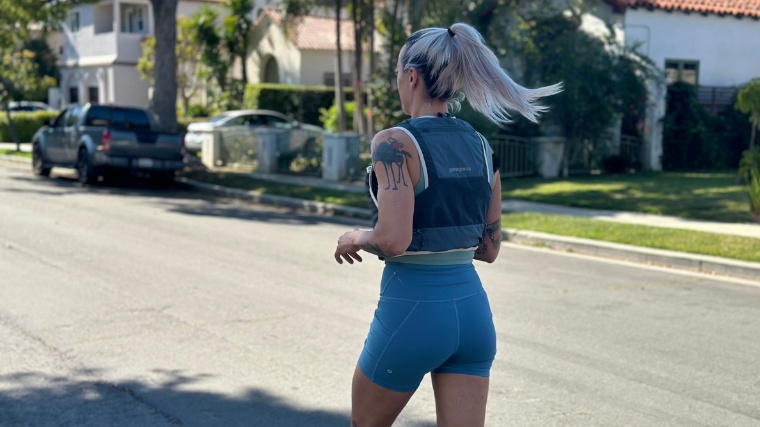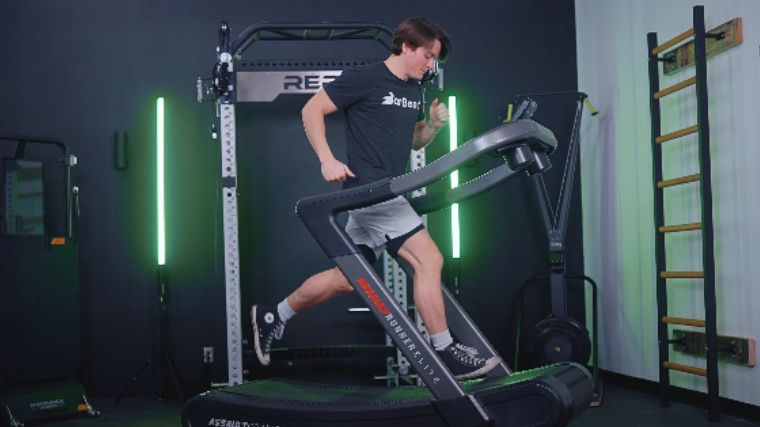Watching marathoners cross a finish line or sprinters barrel down a track is so inspiring. Maybe you’ve wondered what it takes to perform like that, and how running physically changes a person. Whether you’re yearning to be a track star or are simply interested in running as a way to improve your wellness, we’ve got answers for you.

With the help of scientific studies and running coach April Gatlin at STRIDE Fitness, we cover how running changes your body in the moment and over the long term if you make it a habit.
[Read More: How to Run a Mile Without Stopping]
Key Takeaways
- Regular running impacts your body composition, cardiovascular health, musculoskeletal health, and mental health.
- Running helps reduce your risk of cardiovascular disease and bone density loss (osteoporosis).
- Running strengthens the muscles in your lower body, including your quadriceps, hamstrings, glutes, and calves. It has minimal effect on muscles in the upper body.
- Running can be aerobic exercise or anaerobic exercise, depending on the type, distance, and intensity of the run. These affect your fitness differently.
- Running releases endorphins that are known to improve mental health.
- Running can help with weight loss and fat loss, but nutrition and strength training are important parts of the equation.
How Does Running Change Your Body Right Away?
When you head out for a run, you’ll undoubtedly notice some immediate changes, even if you run at an easy pace.
While running, you’ll experience:
- Elevated heart rate
- Increased breathing rate
- Increase in lactic acid in your muscles
- Increased blood pressure
As your body undergoes these physiological changes, you may note feelings such as:
- Your chest pounding and lungs burning
- You’re huffing and puffing
- Blood rushing or pumping harder
- Your leg muscles burning
The level to which these effects occur depends entirely on the intensity and duration of your run. If you head out for a 30-minute run at an easy pace, for instance, your breathing and heart rate will only increase slightly. Experienced runners are unlikely to feel any sort of burning in their legs at an easy pace, although beginners might.
[Read More: The Best Leg Exercises and Workouts for Stronger Legs]
Over longer distances, it’s natural for your heart rate and breathing rate to continue increasing incrementally, even if the pace is within your easy zones.
If you’re in the middle of a high-intensity sprint interval session, your body will be working much harder and thus the physiological changes that occur will be magnified—and you’ll certainly notice them.
How Does Running Change Your Body Long-Term?
As you probably guessed, all those things you feel when running mean that something bigger-picture is happening. In fact, running impacts every bodily system in one way or another. Here’s a look at some key changes that take place when you begin running on a regular basis.
It Changes Body Composition
If you took up running to lose weight, you’re in luck. Running can help you lose body fat because it burns calories. When you burn more calories than you consume each day, you’ll be in a calorie deficit, which is a fundamental requirement to lose weight. (1)
Gatlin explains that not only does the act of running burn calories—but when consistently running, a person’s metabolic rate increases. Your metabolism remains elevated post-run due to something called excess post-exercise oxygen consumption (EPOC). This enables slightly greater calorie burn in the post-run period. The longer and more intense your run, the more calories you’ll burn during the run itself and in the EPOC period. (2)(3)

[Read More: The Best Treadmills for Running, Tested by Fitness Experts]
“Newer runners will notice a quicker weight loss as their body is adapting quickly, as well as losing some water weight,” Gatlin says. “After the initial drop in weight, there will be more of a leveled, consistent reduction in body weight with proper nutrition.”
Importantly, if you are looking to “tone up” (aka build muscle), you’ll want to include strength training in your weekly routine. While running does build muscle in people who were previously non-runners (and very high-intensity running, e.g., sprints may build muscle), it doesn’t add muscle mass like resistance training does. (4)(5)
It Improves Endurance and Stamina
Running is cardio, a form of exercise that primarily taxes your heart and lungs. It improves multiple markers of cardiovascular fitness, including aerobic threshold, lactate threshold, VO2 max, and resting heart rate. (6)
Over time, this means you’ll be able to run longer distances at faster paces with less stress on the body—that is, your fitness level will improve.
It Improves Cardiovascular Health
Physical activity in general is known to vastly improve the health of your cardiovascular system: your heart, lungs, and blood vessels.
“Cardiovascular exercise is working the heart, which is a muscle,” Gatlin says. “The stronger the heart, the stronger the body! When running consistently, the body becomes more efficient at pumping blood with each heartbeat, which will lower the resting heart rate. Also, running can help reduce blood pressure and promote better blood flow.”
[Read More: Supercharge Your Cardio With This Hill Running Workout From a Running Coach]
Because of these effects, running reduces your risk of heart disease, including high blood pressure, high cholesterol, coronary artery disease, heart attack, and stroke. (7)
It Impacts Metabolic Health
In addition to improving heart health, running also improves metabolic health. Specifically, research shows that habitual aerobic activity can:
- Increase insulin sensitivity and lower risk of type 2 diabetes; (8)
- Reduce triglyceride levels; (9)
- Improve blood lipid metabolism. (10)
It Improves Musculoskeletal Health
Running has a substantial impact on your bones, joints, and muscles.
Because it’s a form of weight-bearing exercise, running can minimize bone density as you age, reducing your risk of developing osteoporosis. And, contrary to popular belief, research shows that running can actually be good for your knees—not detrimental. (11)(12)
As for your muscles, Gatlin explains that the primary muscle groups affected include:
- The lower body (quadriceps, glutes, hamstrings, calves, hip flexors)
- The core (abdominals and lower back) and postural muscles (shoulders, upper back)
- And a few upper body muscles including the shoulders and latissimus dorsi (due to arm swing)
[Read More: The Best Upper Body Exercises and Workouts]
The Mental Health Effects of Running
The positive effects of running aren’t limited to physical health. A regular running routine, regardless of the type or distance of runs you do, can result in some profound mental health benefits, too.
Some of the documented mental health benefits of running include: (13)
- Improved mood;
- Relief of tension;
- Improved self-image;
- Reduced anxiety, stress, and depression.
Injury Risk Increases
I don’t want to scare you away from running, but I’d be remiss not to mention the potential injury risk that comes with running. There is inherent risk with any physical activity, but that doesn’t mean you should avoid it: The benefits far outweigh the potential risk.
A few common running injuries include those to the knee, such as runner’s knee and tears to the hamstring, quads, and ligaments in the knee, Gatlin says. “The best way to avoid injury is to cross-train,” she says. To mitigate your risk of injury, “do strength training two to three times per week to strengthen the muscles and avoid imbalances.”

[Read More: How To Choose Running Shoes: Details You Need To Know]
Gatlin also notes that getting fitted for proper running shoes can help. A local running store can help you find shoes suited to your gait and stride. If you lose weight, consider getting a new fitting, because your body weight may start to distribute differently, Gatlin says.
How to Start Running
Ready to hit the pavement? Here are some tips to help you get started.
- Don’t worry about going long-distance at first. Start small and start slow to avoid burnout and overtraining syndrome.
- Remember that running is simple. All you need is a good pair of shoes, comfortable clothing, and water to get started—don’t get overwhelmed by all of the gear you may think you need.
- Plan your route and choose your running outfit in advance to build confidence.
- Always warm up before you run, and spend a few minutes stretching when you’re done.
- Aim for one to three runs per week when you start, and build from there.
- Try to incorporate at least one strength day in your weekly routine.
Frequently Asked Questions
Can running change your body shape?
Yes, running can change your body shape. Running burns calories, which can help you achieve a calorie deficit. When you’re in a calorie deficit, you burn more calories than you consume, which is how you lose weight.
Can running tone your stomach?
Running is a whole-body form of exercise. While it may help you lose weight and burn body fat overall, running does not uniquely target stomach fat—nor does any other type of exercise. Spot fat reduction is a myth—more or less.
What parts of the body does running tone?
Running primarily works the lower body. When you begin running, you’ll likely develop some muscle mass in your quads, hamstrings, calves, and glutes.
Does running tone your butt?
“Toning” is the result of building muscle and losing fat. Running can help you lose body fat and build some muscle, but strength training is the quicker and more efficient way to build muscle. Exercises like squats, lunges, hip thrusts, and Romanian deadlifts can help you build your glute muscles, which creates the appearance of a toned butt.
Editor’s Note: The content on BarBend is meant to be informative in nature, but it should not be taken as medical advice. When starting a new training regimen and/or diet, it is always a good idea to consult with a trusted medical professional. We are not a medical resource. The opinions and articles on this site are not intended for use as diagnosis, prevention, and/or treatment of health problems. They are not substitutes for consulting a qualified medical professional.
References
- Kutac P, Bunc V, Buzga M, Krajcigr M, Sigmund M. The effect of regular running on body weight and fat tissue of individuals aged 18 to 65. J Physiol Anthropol. 2023;42(1):28.
- Knab AM, Shanely RA, Corbin KD, Jin F, Sha W, Nieman DC. A 45-minute vigorous exercise bout increases metabolic rate for 14 hours. Med Sci Sports Exerc. 2011;43(9):1643-1648.
- Batliner ME, Kipp S, Grabowski AM, Kram R, Byrnes WC. Does Metabolic Rate Increase Linearly with Running Speed in all Distance Runners?. Sports Med Int Open. 2017;2(1):E1-E8.
- Grgic J, Mcllvenna LC, Fyfe JJ, et al. Does Aerobic Training Promote the Same Skeletal Muscle Hypertrophy as Resistance Training? A Systematic Review and Meta-Analysis. Sports Med. 2019;49(2):233-254.
- Nuell S, Illera-Domínguez VR, Carmona G, et al. Hypertrophic muscle changes and sprint performance enhancement during a sprint-based training macrocycle in national-level sprinters. Eur J Sport Sci. 2020;20(6):793-802.
- Hespanhol Junior LC, Pillay JD, van Mechelen W, Verhagen E. Meta-Analyses of the Effects of Habitual Running on Indices of Health in Physically Inactive Adults. Sports Med. 2015;45(10):1455-1468.
- Lee DC, Pate RR, Lavie CJ, Sui X, Church TS, Blair SN. Leisure-time running reduces all-cause and cardiovascular mortality risk [published correction appears in J Am Coll Cardiol. 2014 Oct 7;64(14):1537]. J Am Coll Cardiol. 2014;64(5):472-481.
- Kutac P, Bunc V, Buzga M, Krajcigr M, Sigmund M. The effect of regular running on body weight and fat tissue of individuals aged 18 to 65. J Physiol Anthropol. 2023;42(1):28.
- Wang Y, Shen L, Xu D. Aerobic exercise reduces triglycerides by targeting apolipoprotein C3 in patients with coronary heart disease. Clin Cardiol. 2019;42(1):56-61
- Nogal B, Vinogradova S, Jorge M, Torkamani A, Fabian P, Blander G. Dose response of running on blood biomarkers of wellness in generally healthy individuals. PLoS One. 2023;18(11):e0293631.
- Horga LM, Henckel J, Fotiadou A, et al. Is the immediate effect of marathon running on novice runners’ knee joints sustained within 6 months after the run? A follow-up 3.0 T MRI study. Skeletal Radiol. 2020;49(8):1221-1229. doi:10.1007/s00256-020-03391-2
- Ponzio DY, Syed UAM, Purcell K, et al. Low Prevalence of Hip and Knee Arthritis in Active Marathon Runners. J Bone Joint Surg Am. 2018;100(2):131-137.
- Oswald F, Campbell J, Williamson C, Richards J, Kelly P. A Scoping Review of the Relationship between Running and Mental Health. Int J Environ Res Public Health. 2020;17(21):8059.
Featured Image: TunedIn by Westend61 / Shutterstock
The post How Does Running Change Your Body? An Expert Weighs In appeared first on BarBend.
from BarBend https://ift.tt/QIA0uoY
via IFTTT
Comments
Post a Comment